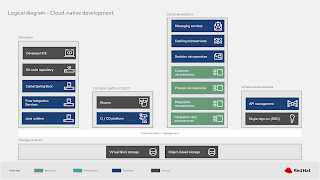 |
| Part 2 - Common architectural elements |
In this article we continue with a look at the common architectural elements. A description is provided to guide you with aligning what we've presented here with the landscape your organization works with every day.
These details should help you understand both what the elements contain and how they might align and how their functionalities are grouped.
Let's look at the foundation of our cloud-native development architecture, the logical diagram with it's architectural elements.




